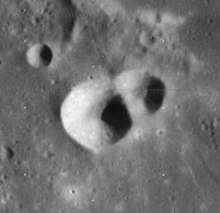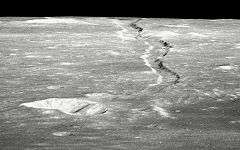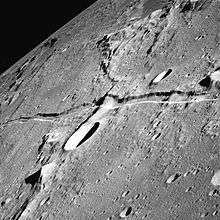Ariadaeus (crater)
Ariadaeus is a small, bowl-shaped lunar impact crater on the western shores of Mare Tranquillitatis. It lies to the north of the crater Dionysius, and to the west-southwest of Arago. The crater is joined along the northeast rim by the slightly smaller Ariadaeus A, and the two form a double-crater. Its diameter is 10.4 km.[1]
 Lunar Orbiter 4 image | |
| Coordinates | 4.6°N 17.3°E |
|---|---|
| Diameter | 10.4 km |
| Depth | 1.8 km |
| Colongitude | 342° at sunrise |
| Eponym | Philippus Arrhidaeus |

This crater marks the eastern extent of the rille designated Rima Ariadaeus. This wide rille extends in a nearly straight line to the west-northwest, passing just to the north of the crater Silberschlag. Other rille systems lie in the vicinity, including the Rimae Ritter to the southeast and Rimae Sosigenes to the northeast.
The crater was named after Philip III of Macedon (Arrhidaeus).[1][2]
Satellite craters
By convention these features are identified on lunar maps by placing the letter on the side of the crater midpoint that is closest to Ariadaeus.
| Ariadaeus | Latitude | Longitude | Diameter |
|---|---|---|---|
| A | 4.6° N | 17.5° E | 8 km |
| B | 4.9° N | 15.0° E | 8 km |
| D | 4.9° N | 17.0° E | 4 km |
| E | 5.3° N | 17.7° E | 24 km |
| F | 4.4° N | 18.0° E | 3 km |
Notes
- "Ariadaeus (crater)". Gazetteer of Planetary Nomenclature. USGS Astrogeology Research Program.
- Antonín Rükl, Atlas of the Moon (Hamlyn, 1991), p. 96.
References
- Andersson, L. E.; Whitaker, E. A. (1982). NASA Catalogue of Lunar Nomenclature. NASA RP-1097.CS1 maint: ref=harv (link)
- Bussey, B.; Spudis, P. (2004). The Clementine Atlas of the Moon. New York: Cambridge University Press. ISBN 978-0-521-81528-4.CS1 maint: ref=harv (link)
- Cocks, Elijah E.; Cocks, Josiah C. (1995). Who's Who on the Moon: A Biographical Dictionary of Lunar Nomenclature. Tudor Publishers. ISBN 978-0-936389-27-1.CS1 maint: ref=harv (link)
- McDowell, Jonathan (July 15, 2007). "Lunar Nomenclature". Jonathan's Space Report. Retrieved 2007-10-24.CS1 maint: ref=harv (link)
- Menzel, D. H.; Minnaert, M.; Levin, B.; Dollfus, A.; Bell, B. (1971). "Report on Lunar Nomenclature by the Working Group of Commission 17 of the IAU". Space Science Reviews. 12 (2): 136–186. Bibcode:1971SSRv...12..136M. doi:10.1007/BF00171763.CS1 maint: ref=harv (link)
- Moore, Patrick (2001). On the Moon. Sterling Publishing Co. ISBN 978-0-304-35469-6.CS1 maint: ref=harv (link)
- Price, Fred W. (1988). The Moon Observer's Handbook. Cambridge University Press. ISBN 978-0-521-33500-3.CS1 maint: ref=harv (link)
- Rükl, Antonín (1990). Atlas of the Moon. Kalmbach Books. ISBN 978-0-913135-17-4.CS1 maint: ref=harv (link)
- Webb, Rev. T. W. (1962). Celestial Objects for Common Telescopes (6th revised ed.). Dover. ISBN 978-0-486-20917-3.CS1 maint: ref=harv (link)
- Whitaker, Ewen A. (1999). Mapping and Naming the Moon. Cambridge University Press. ISBN 978-0-521-62248-6.CS1 maint: ref=harv (link)
- Wlasuk, Peter T. (2000). Observing the Moon. Springer. ISBN 978-1-85233-193-1.CS1 maint: ref=harv (link)
External links
| Wikimedia Commons has media related to Ariadaeus (crater). |

